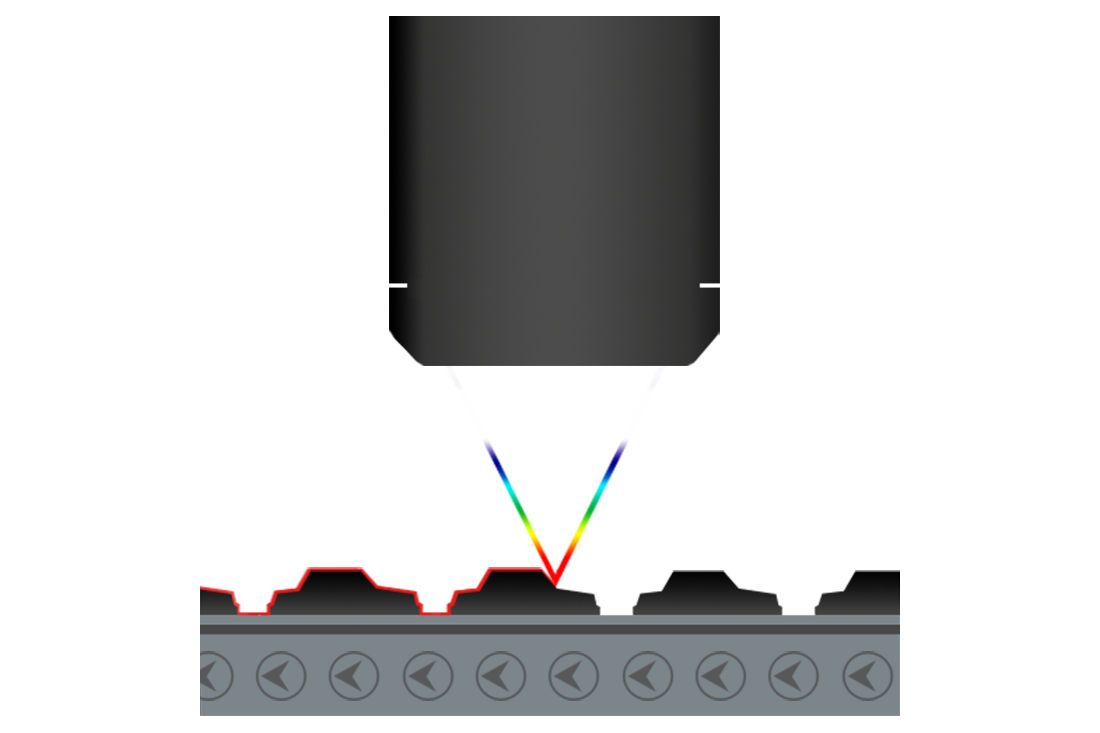Non contact defects inspection
Vision systems have a double role: provide a good-quality image of the sample surface with the desired magnification and process the image in order to detect and analyze some predefined features or textures.
While the processing units get more and more powerful, the basic limitation of current Vision systems resides in their very small depth of focus (a few dozens of µm or less, depending on the numerical aperture). Due to this limitation, expensive and complicated Z scanning systems and / or autofocus mechanism are required for viewing samples with larger Z extension and moving samples.

Chromatic confocal microscopy is a technology allowing the design of optical systems with a very large depth of focus (up to several mm). For samples located anywhere within the extended depth of focus view these system provide a sharp, high quality and perfectly focused image.
This technology combines the merits of color coding and of traditional confocal microscopes. Chromatic confocal microscopes consist of a slit illuminated by a polychromatic light source, a high quality chromatic lens, a beam separator and a 4K line camera.
- Large Depth of Field (DOF) : Millimeters DOF instead of 10th of µm for microscopes
- Less/no focussing required
- Focus on glass & mirror becomes possible
- Resolution (X-Y) Pixel size on sample ≥ 0,43 µm*0.43µm
- High Speed up to 199.5 klines per second
- Works on any material Metal (polished or rough), Glass, Ceramics, Plastics …
|
Product |
|
MC2 NanoView |
MC2 WireView |
MC2 MicroView |
MC2 DeepView mk2 |
MC2 SuperView |
|
Order Code |
|
OPSTM702002 |
OPSTM708002 |
OPSTM704002 |
OPSTM706002 |
OPSTM709002 |
|
Line Length |
mm |
1,34 |
1,51 |
1,8 |
4,2 |
12,85 |
|
Depth of field |
µm |
120 |
900 |
500 |
2600 |
2000 |
|
Working distance |
mm |
7,4 |
7,8 |
10,1 |
19,5 |
11,3 |
|
Magnification |
|
17,3 |
15,6 |
12,9 |
5,6 |
1,8 |
|
Numerical aperture |
|
0,75 |
0,75 |
0,5 |
0,37 |
0,33 |
|
Max. sample slope |
° |
43 |
46 |
30 |
20 |
17 |
|
Pixel size on the sample |
µm |
0,43 |
0,49 |
0,58 |
1,35 |
4,1 |
|
Optical part: Length |
mm |
421,6 |
468 |
412,8 |
400,5 |
370 |
|
Optical Part: Diameter |
mm |
50 |
70 |
50 |
60 |
60 |
|
Optical Part: Weight |
g |
5300 |
5800 |
5200 |
5850 |
5600 |
